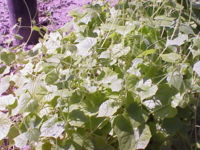| Caigua {{{status}}} Fossil range: {{{fossil_range}}}
|

|
| Plant Info
|
| Common name(s):
|
|
{{{common_names}}}
|
| Growth habit:
|
|
{{{growth_habit}}}
|
| Height:
|
⇕
|
{{{high}}}
|
| Width:
|
⇔
|
{{{wide}}}
|
| Lifespan:
|
⌛
|
{{{lifespan}}}
|
| Exposure:
|
☼
|
{{{exposure}}}
|
| Water:
|
☂
|
{{{water}}}
|
| Features:
|
❀
|
{{{features}}}
|
| Poisonous:
|
☠
|
{{{poisonous}}}
|
| Hardiness:
|
❆
|
{{{hardiness}}}
|
| USDA Zones:
|
|
{{{usda_zones}}}
|
| Sunset Zones:
|
|
{{{sunset_zones}}}
|
|
| Scientific classification
|
| Domain:
|
{{{domain}}}
|
| Superkingdom:
|
{{{superregnum}}}
|
| Kingdom:
|
Plantae
|
| Subkingdom:
|
{{{subregnum}}}
|
| Superdivision:
|
{{{superdivisio}}}
|
| Superphylum:
|
{{{superphylum}}}
|
| Division:
|
Magnoliophyta
|
| Phylum:
|
{{{phylum}}}
|
| Subdivision:
|
{{{subdivisio}}}
|
| Subphylum:
|
{{{subphylum}}}
|
| Infraphylum:
|
{{{infraphylum}}}
|
| Microphylum:
|
{{{microphylum}}}
|
| Nanophylum:
|
{{{nanophylum}}}
|
| Superclass:
|
{{{superclassis}}}
|
| Class:
|
Magnoliopsida
|
| Sublass:
|
{{{subclassis}}}
|
| Infraclass:
|
{{{infraclassis}}}
|
| Superorder:
|
{{{superordo}}}
|
| Order:
|
Cucurbitales
|
| Suborder:
|
{{{subordo}}}
|
| Infraorder:
|
{{{infraordo}}}
|
| Superfamily:
|
{{{superfamilia}}}
|
| Family:
|
Cucurbitaceae
|
| Subfamily:
|
{{{subfamilia}}}
|
| Supertribe:
|
{{{supertribus}}}
|
| Tribe:
|
{{{tribus}}}
|
| Subtribe:
|
{{{subtribus}}}
|
| Genus:
|
Cyclanthera
|
| Subgenus:
|
{{{subgenus}}}
|
| Section:
|
{{{sectio}}}
|
| Series:
|
{{{series}}}
|
| Species:
|
C. pedata
|
| Subspecies:
|
{{{subspecies}}}
|
|
| [[{{{diversity_link}}}|Diversity]]
|
| {{{diversity}}}
|
| Binomial name
|
Cyclanthera pedata
(L.) Schrader
|
| Trinomial name
|
{{{trinomial}}}
|
| Type Species
|
{{{type_species}}}
|
| {{{subdivision_ranks}}}
|
|
|
[[Image:{{{range_map}}}|{{{range_map_width}}}|]]
|
| Synonyms
|
| Momordica pedata L.
|
The caigua (pronounced kai-wa) is a vine grown for its small fruit, used as a vegetable. It is also known as caygua, caihua, cayua, achocha, achokcha, slipper gourd, lady's slipper, sparrow gourd (Template:Zh-cp), stuffing cucumber, or korila.
Extracts from the fruit may have medicinal value.
Origin and distribution
Likely domesticated in the Andes, the caigua is now grown many parts of Central America and South America, as well as parts of the Eastern Hemisphere tropics.
Food uses
The immature fruits may be eaten raw or pickled. Unlike many cucurbitaceous fruits, the caigua become quite hollow as it matures, and the mature fruit is often eaten stuffed. The young shoots and leaves may also be eaten as greens.
External links
Template:Unimelb
Template:Vegetable-stub
